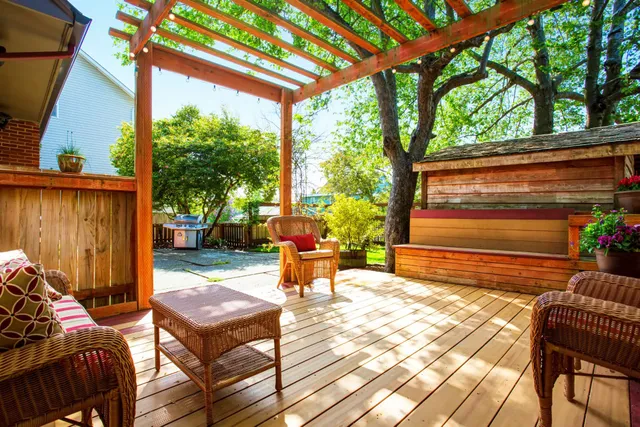Using hardwood for outdoor spaces such as decks, patios, and other outdoor living areas can create a warm, inviting atmosphere while blending seamlessly with natural surroundings. Here are some key points to consider when choosing hardwood for outdoor use, types of suitable wood, and maintenance tips.

Types of Hardwood and Treatments for Outdoor Use
1. Ipe (Brazilian Walnut):
Ipe is an extremely hard, dense wood that is resistant to rot, insects, and weather. It has a rich, dark brown color. The natural oils within the wood offer protection, allowing it to be left untreated for a silver-grey patina or treated with UV protectant oils to maintain its original color.
2. Teak:
Teak is naturally resistant to water, insects, and decay, with a golden-brown color. It is often used untreated, developing a silver patina over time, but can also be treated with teak oil to maintain its color.
3. Cumaru (Brazilian Teak):
Cumaru is a very dense, durable wood that is resistant to rot and insects. It has a reddish-brown color and can be left to weather naturally or treated with UV protectant oils, similar to Ipe.
4. Garapa (Brazilian Ash):
Garapa is a light-colored wood that is durable and resistant to decay and insects. It can be treated with sealers and UV protectants to maintain its color or left to weather to a silver-grey.
5. Mahogany:
Mahogany is stable, durable, and resistant to decay and insects, with a reddish-brown hue. It requires regular maintenance with sealers or oils to maintain its color and protect it from weathering.
Treatments for Hardwood
1. Oil-Based Sealers:
Oil-based sealers penetrate the wood and protect from within. They typically require reapplication every 1-2 years and enhance the natural wood grain and color.
2. Water-Based Sealers:
Water-based sealers form a protective layer on the wood’s surface and usually need reapplication more frequently than oil-based sealers. They offer UV protection to prevent fading.
3. Stains with Sealers:
These products provide color and protection in one application. They are available in a variety of colors to match aesthetic preferences.
4. UV Protectant Oils:
Designed specifically to prevent fading from sun exposure, UV protectant oils typically need to be reapplied annually.
Maintenance Tips for Outdoor Hardwood Floors
1. Regular Cleaning:
Regularly sweep to remove dirt and debris. Wash the wood with a mild soap solution and a soft brush or mop. Avoid using harsh chemicals or pressure washers, as they can damage the wood.
2. Reapplication of Treatments:
Depending on the treatment used, reapply oils, sealers, or stains as recommended, usually annually or biannually. Always clean the surface thoroughly before reapplying treatments.
3. Inspect and Repair:
Regularly inspect the wood for signs of wear, damage, or rot. Replace or repair damaged boards promptly to prevent further deterioration.
4. Furniture and Foot Traffic:
Use pads or protective covers on furniture legs to prevent scratches. Consider using rugs or mats in high-traffic areas to reduce wear.
5. Protection from Elements:
Use canopies, pergolas, or umbrellas to protect the wood from direct sunlight and rain. During extreme weather, cover the deck with protective tarps.
By selecting the right type of hardwood and maintaining it properly, you can enjoy the beauty and durability of hardwood floors in your outdoor spaces for many years.